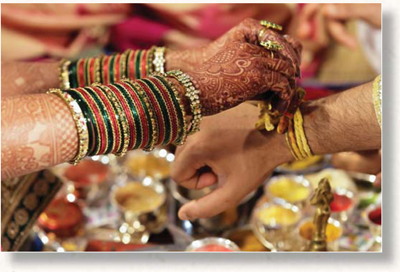
E D U C A T I O N A L I N S I G H T§
Hindu Wedding
The Sacred Rites of Matrimony §
§
___________________________
Excerpted from Vivaha Samskara,
The Hindu Wedding Ceremony§
___________________________§
Published by the Hindu Mandir Executives’ Conference§
In this Educational Insight, we present a pictorial summary of the Hindu wedding ceremony, with text drawn from a new book, Vivaha Samskara, designed particularly for Hindus living in the diaspora and released in 2011 as a guide to this sacred event. It encompasses all the basic aspects of the traditional rites and incorporates a few key innovations for contemporary times. §
 t all started at the wedding of my daughter Rupali in 2005. Right after the wedding ceremony, the daughter of a family friend informed me that she had just gotten engaged and wanted me to be her wedding purohita (priest). I had never done this before, so I did not accept immediately. Having attended many Hindu weddings in the US over the last two decades, I felt that the ceremony could be made more meaningful to the couple and the invited guests, since most people do not understand Sanskrit, the language of the ceremony. I accepted the request after studying the subject in depth. ¶After officiating one wedding, I was requested by many Hindu friends and acquaintances to officiate their children’s weddings. In the meetings prior to these weddings, I always explain the ceremony and its significance to the couple. Due to the lack of a reference book in English, I decided to write a book specifically for the Hindu diaspora and even Hindus in India. §
t all started at the wedding of my daughter Rupali in 2005. Right after the wedding ceremony, the daughter of a family friend informed me that she had just gotten engaged and wanted me to be her wedding purohita (priest). I had never done this before, so I did not accept immediately. Having attended many Hindu weddings in the US over the last two decades, I felt that the ceremony could be made more meaningful to the couple and the invited guests, since most people do not understand Sanskrit, the language of the ceremony. I accepted the request after studying the subject in depth. ¶After officiating one wedding, I was requested by many Hindu friends and acquaintances to officiate their children’s weddings. In the meetings prior to these weddings, I always explain the ceremony and its significance to the couple. Due to the lack of a reference book in English, I decided to write a book specifically for the Hindu diaspora and even Hindus in India. §
Marriage ties: A couple walks around the homa kunda as they embark on a lifetime of joyful and fruitful togetherness during their marriage ceremony. Deepak Kotwal, primary author of Vivaha Samskara, conducts a wedding in his community.
• • • • • • • • • • • • • • • •§
I met Shri Sanjay Mehta, an active member of the Hindu Mandir Executives’ Conference (HMEC), after I started writing. With his encouragement, it was decided that the book would be published under the auspices of the HMEC, as it neatly complemented the common objective of sustaining Hindu Dharma.§
From the Preface, by Deepak Kotwal§
• • • • • • • • • • • • • • • •
TECHNICAL ADVICE AND ASSISTANCE WITH PHOTO SELECTION & CAPTION WRITING BY PADMAJA PATEL, OF MIDLAND, TEXAS§
• • • • • • • • • • • • • • • • • • • • • • • • • • • •
To order the book go to: www.Hindu-Wedding.org§
Introduction

 N THE MID 1960S, INDIAN PROFESSIONALS started arriving in the US in large numbers after the enactment of the Immigration and Nationality Act, which changed the basis of US immigration policy. A majority of these Indian immigrants grew up in the tradition of Sanatana Dharma, commonly called the Hindu religion. As they settled in a newly adopted country and their children grew up in the non-Hindu-majority American society, they perceived a great need to preserve and propagate their own Hindu identity to the next generation. Many Hindu temples were built, and purohitas (priests) trained in India were brought in to properly observe temple traditions. As of 2010, there were approximately 600+ Hindu temples and institutions in North America. The Indian purohitas came well trained in performing the daily temple rituals, as well as conducting the samskaras for the devotees, such as upanayana (sacred thread ceremony) and vivaha (wedding). Purohitas generally do not deliver a sermon to a congregation, as in the traditions of some other religions.§
N THE MID 1960S, INDIAN PROFESSIONALS started arriving in the US in large numbers after the enactment of the Immigration and Nationality Act, which changed the basis of US immigration policy. A majority of these Indian immigrants grew up in the tradition of Sanatana Dharma, commonly called the Hindu religion. As they settled in a newly adopted country and their children grew up in the non-Hindu-majority American society, they perceived a great need to preserve and propagate their own Hindu identity to the next generation. Many Hindu temples were built, and purohitas (priests) trained in India were brought in to properly observe temple traditions. As of 2010, there were approximately 600+ Hindu temples and institutions in North America. The Indian purohitas came well trained in performing the daily temple rituals, as well as conducting the samskaras for the devotees, such as upanayana (sacred thread ceremony) and vivaha (wedding). Purohitas generally do not deliver a sermon to a congregation, as in the traditions of some other religions.§
As Hindu young adults in North America reached the age when marriages are usually performed, it was natural for them and their parents to wish for a proper Hindu wedding ceremony. Even in Hindu/non-Hindu unions, the desire for a Hindu ceremony is strong on the part of Hindu parents, as well as second-generation Hindu young men and women in North America. Although a number of books are available on the topic of Hindu wedding social customs, we felt a need for a book in English specifically geared toward meeting the multifaceted requirements of the diaspora, as well as Hindus in India who follow the “Don’t ask, don’t tell, just do!” practice when it comes to performing symbolically rich rituals.§
Differing social customs are followed in a vivaha samskara depending on the region (within India) of family origin. This first edition of the book does not list or delve into the region-specific practices and rituals associated with Hindu weddings. Our intention is to focus on the Vedic roots of the essential steps in a vivaha samskara and to sustain a common Hindu identity. Although Vivaha Samskara is a result of the needs of North American Hindus, it is intended for all Hindus anywhere in the world. Our key objectives are as follows.§

Living traditions: The bride’s sacred wedding necklace and other jewelry are laid out for blessing on a tray adorned with betel leaves, areca nuts, unbroken rice and flowers. A newly married couple confidently ponder their future as husband and wife. To this day, Hindu couples strive to preserve the traditional wedding ceremony, which has its roots in the Rig Veda. Core members of the team that produced the book, Vivaha Samskara. Nana Datar, Arun Jatkar, Deepak Kotwal (gold kurta), Dilip Amin, and supporter Dileep Thatte.
• • • • • • • • • • • • • • • •§
Educating Young Hindus§
The Hindu wedding ceremony comes to us from the Rig Veda, the most sacred book of the Hindus. It is written in the archaic version of what eventually became the Indian classical language Sanskrit (Saṁskṛta). One of the important duties of the purohita is to ensure that the couple getting married understands the steps in the ceremony. Most people have not studied the Sanskrit language, making it difficult for the couple to follow the ceremony. The English-language skills of the purohitas from India at present may not be adequate to explain the symbolism of the rituals to couples whose mother tongue is essentially English. This will change over time. The foremost purpose of this book is to educate and empower Hindu young adults entering the married stage of life. The couple should be aware of the meaning of the samskaras and the sublime ideals enshrined in them. §
A Guide for Bride, Groom and Parents in the Diaspora§
The generation of Hindus who immigrated to North America in the 1960s and 1970s generally had their own weddings performed in the traditional Hindu Vedic way, in India in most cases. It is not a common practice for purohitas in India to explain the symbolism of the steps to the couple or the attendees. Second-generation Hindus in North America are curious about their roots and heritage, but they may not get enough information from their own elders. Therefore, the second purpose of the book is to provide a reference source to the bride, the groom and their parents as they prepare for their wedding.§
Vedic Hindu Vivaha Procedural Adaptation§
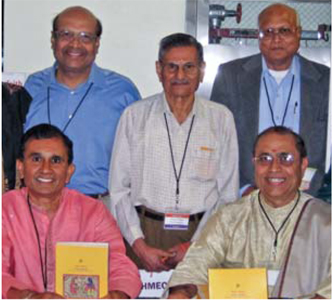 Hindu Dharma rituals have evolved over several millennia. The third purpose of this book is to provide a Vedic Hindu vivaha vidhi (marriage procedure) with a few adaptations to reflect contemporary reality. The young generation of North American Hindus have generally been born and brought up in North America. Their identification with the region of family origin in India is much weaker than that of their parents, who are mostly first-generation immigrants. Therefore, this book promotes a common Hindu identity regardless of the family’s regional origin.§
Hindu Dharma rituals have evolved over several millennia. The third purpose of this book is to provide a Vedic Hindu vivaha vidhi (marriage procedure) with a few adaptations to reflect contemporary reality. The young generation of North American Hindus have generally been born and brought up in North America. Their identification with the region of family origin in India is much weaker than that of their parents, who are mostly first-generation immigrants. Therefore, this book promotes a common Hindu identity regardless of the family’s regional origin.§
The traditional Vedic Brahma Vivaha ceremony does not include a step wherein the bride and the groom state their acceptance of each other as life partners. It is presumed to have been done. The reality in the life of 21st-century Hindus in North America is that the bride and groom themselves may choose each other, with their parents’ consent or with relatively minimal parental involvement. We have added a mutual-consent step to the traditional ceremony.§
In the traditional Vedic sapta-pada (rite of seven steps), the groom expresses the couple’s wishes for their married life. This book provides an alternative set of verses for sapta-pada wherein the bride and groom express their shared prayers and aspirations.§
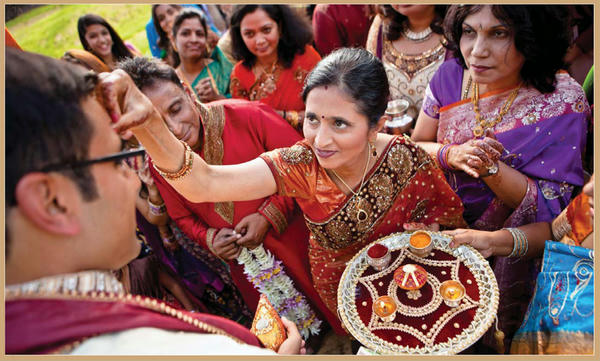
The joining of two families: The bride’s family gathers to welcome the groom, as her mother places a dot of kumkum on his forehead
• • • • • • • • • • • • • • • •§
An English Reference for Purohitas §
The Indian-trained purohitas bring thousands of years of Hindu ritual practices to the ceremony. They rightfully follow the shastras and traditions they learned. Their contribution to the sustenance of Hindu Dharma and to the creation of North American Hindus’ unique identity is enormous. The ancestral lineage of the purohita, the tradition he belongs to and the region he comes from all impact the way he conducts the vivaha samskara. It is not the intention of this book to suggest any alterations in the practices of the properly trained purohita. As they gain experience in conducting weddings in North America, they may adapt to contemporary situations. This book is intended to assist purohitas in their meetings and communications with the couple and their parents.§
Although the large cities of North America now have established Hindu temples with trained purohitas, there are many small towns where a properly qualified purohita may not be available to perform the wedding ceremony. Using this book, a practicing Hindu with fundamental knowledge of Hindu dharma, a strong desire to sustain it, familiarity with our ritual practices, sufficient knowledge of Sanskrit and the ability to properly pronounce Sanskrit words should be able to conduct the ceremony. The acting purohita is encouraged to ask the couple and their elders to read this book prior to the meetings in which they will decide the details of their ceremony.§
In a Hindu wedding ceremony, the attendees have two important roles: they are observant eyewitnesses to the bride’s and groom’s commitments to each other and the couple’s commitment to society, and they bless the couple to sanctify the union. §
Hindu/non-Hindu Interfaith Marriages§
As the 21st century dawns in North America, it is not uncommon for a young Hindu adult to choose a non-Hindu spouse. Such interfaith couples face many divisive issues related to the differences in their religious beliefs, especially if the non-Hindu religion is essentially exclusivist in its central tenet. The fifth purpose of the book is to ensure that a Hindu contemplating marrying a non-Hindu addresses potential differences prior to getting married so that these issues do not become festering conflicts with negative effects on harmonious marital relationship.§
Contents of the Book §
- A complete Vedic Hindu Brahma vivaha liturgy in Sanskrit with English transliteration and translation. It constitutes a step-by-step guide to each aspect of the wedding.
- Two modifications for contemporary relevance: mutual consent and joint seven-step pronouncements.
- Explanation of the meaning of Hindu rituals.
- A discussion of Hindu/non-Hindu interfaith marriage issues.
- A complete ceremony for a non-Hindu to become a Hindu.
161 pages, 6"x9", paperback, ISBN 978-0-9793501-3-9, $12§
To purchase the book, visit: www.hindu-wedding.org§
HMEC is an initiative of the World Hindu Council of America (VHPA).§
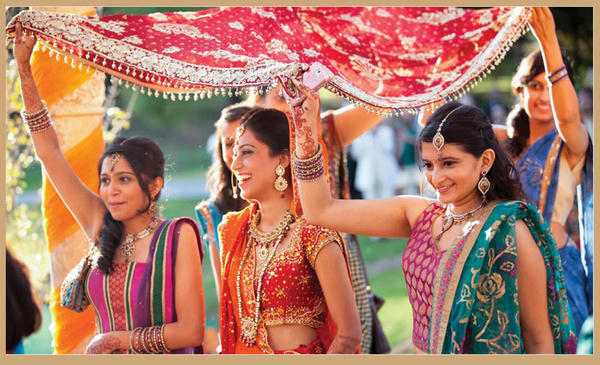
A day of joy: A bride is escorted to the wedding mandapa by her sisters, who hold up a ceremonial canopy
• • • • • • • • • • • • • • • •§
Steps of the Vivaha Samskara
Here we excerpt the detailed wedding procedures found in Vivaha Samskara. The book includes more complete explanations and instructions and provides all the mantras in Sanskrit which our summary gives in English. §
Start of the Ceremony §
After an invocation prayer, the purohita makes an opening statement to briefly explain the ceremony and the attendees’ role therein. The bride’s elders arrive at the mandapa (a pavilion with four pillars and a cloth canopy) and wait for the arrival of the groom’s party. Although weddings generally take place in a public facility nowadays, such as a hotel ballroom, it is deemed to take place at the bride’s elders’ home. Therefore, they arrive first to be the hosts of the event. The groom’s elders then arrive and are welcomed by the bride’s elders. The two families stand together to await the groom. §
Arrival of the Groom§
The groom arrives to the accompaniment of music and is formally welcomed by the bride’s elders. A part of the welcoming ritual involves a puja to the groom, with offerings of a seat, water for washing feet and a mixture of honey and yogurt. The groom is then escorted to his seat on the right side (attendees’ perspective) of the stage. Traditionally, the arrival of the groom and his party to the bride’s village took place at least one day prior to the wedding. Such an arrival with fanfare was a method of announcing that the wedding is scheduled to take place. Anyone with an objection to the union was expected to contact the elders of the bride or groom. Gifts may be presented to the groom at this time.§
Arrival of the Bride §
The bride arrives, accompanied by music and fanfare. She takes her seat on the stage on the left side. It is customary in most parts of India for the maternal uncle to escort the bride to the wedding venue. Nowadays it is recommended that the bride choose as her escort(s) the elder(s) emotionally closest to her; parents in most cases. The groom’s elders perform a puja to the bride. Gifts may be presented to her at this time. §

Meaningful rites: At the beginning of the ceremony, a statement of intent is made and the blessings of Lord Ganesha are sought. In the rite of kanya danam, the bride’s mother pours water into her husband’s hand, which flows into the groom’s hands and then into the bride’s. The father places his daughter’s hand into the groom’s hand. These two acts symbolize the transference of her care and protection to the groom.
• • • • • • • • • • • • • • • •§
Invocation to Lord Ganesha§
At the beginning of any Hindu religious ceremony, Lord Ganesha’s blessings are sought, as He is the remover of all obstacles. This puja is performed by both sets of elders. In this step the bride’s elders and the groom’s elders request the attendees to collectively express the desire that the day and time be meritorious and auspicious for the samskara. §
A statement of intent (sankalpa) is made by the elders and the couple that they are about to perform a wedding ceremony. It is customary to identify the day (according to the Hindu calendar system), names of the persons performing the ceremony, the lineages of the bride and groom and the location where the ceremony is being held.§
The announcement of the gotra (clan-lineage) is particularly noteworthy. In Hindu Dharma, “sagotra vivaha,” i.e., the bride and groom belonging to the same gotra, is forbidden. The announcement of both gotras informs the attendees that the bride and groom belong to different gotras. §
Tying String Around Wrists §
The bride and groom each tie a cord around the other’s wrist symbolizing their commitment to perform the ceremony, their pledge to provide mutual protection and their prayers for good health.§
Bonds of fidelity: Each ties a cord around the wrist of the other, symbolizing mutual protection and prayers for good health
• • • • • • • • • • • • • • • •§
Pledge of Mutual Consent §
This ceremonial step allows the couple to announce their mutual consent. Each one states that she/he has made a mature and wise decision to accept the other as spouse to discharge the duties of the householder stage of life. This step is not a part of the traditional Brahma vivaha. It was added in this book to reflect the contemporary reality for many North American Hindu young adults that the bride and groom choose each other as life partners. §
A pebble soaked in water, a niranjana, a tulasi leaf, darbha grass, flowers and akshata (unbroken grains of rice, colored) should be placed in a copper tray. The groom and the bride hold this tray in their hands and say the following three times in the presence of all the attendees. §
Groom: “My fair lady, I have chosen you as my wife in the same way that Shantanu chose Ganga or Yayati chose Sharmishtha. May the sages, the sacred fire, God Varuna and all other Deities, the Sun, the Moon and the Earth give their consent to our union, and may they bless our union.” §
Bride: “I have reached the age of majority, and I am perfectly capable of making decisions about my career and life. I thoughtfully and joyfully choose you as my husband of my own free will. May the sages, the sacred fire, God Varuna and all other Deities, the Sun, the Moon and the Earth give their consent to our union, and may they bless our union.” §
Now the bride asks the groom three times to take an oath, and the groom takes that oath three times. Bride: “Promise me that you will not transgress my bounds while you pursue religious duties, acquire wealth and seek the fulfillment of earthly desires!” §
Groom: “In the pursuit of my religious duties, acquisition of wealth and fulfillment of earthly desires I shall not transgress your bounds.” §
Giving Away the Bride, Kanya Danam §
In this step, the bride’s mother pours a small stream of holy water from the kalasha (water vessel) onto the bride’s father’s palm, which then flows to the groom’s palm and finally to the bride’s palm. This water stream is collected by the groom’s mother in a copper plate. The symbolism here is that the bride is being entrusted to the groom and that he is now responsible for her protection, with full approval of the parents of the groom and the bride.§
The groom’s response to the bride’s parents after accepting her as his life partner is poetic and noteworthy. He raises a rhetorical question, “Who is the giver and who is the receiver?” He then goes on to provide the answer (paraphrase): “You and I are merely instruments in the hands of Ishvara. It was the wish of Ishvara that brought us together. I accept her with love, just as the parched earth at the end of summer eagerly accepts the first showers of monsoon.”§
One important part of this step is the advice given to the groom by the bride’s father: “Do not transgress her as you pursue your duties, acquire wealth and seek fulfillment of your earthly desires.” The groom repeats three times that he will not do that.§
The act of gifting one’s daughter represents the fulfillment of the parents’ obligation or debt to their ancestors. The perpetuation of society through progeny is considered one of the most important duties of a householder. This act of entrusting the daughter to her husband is done for the sustenance of society through procreation. §
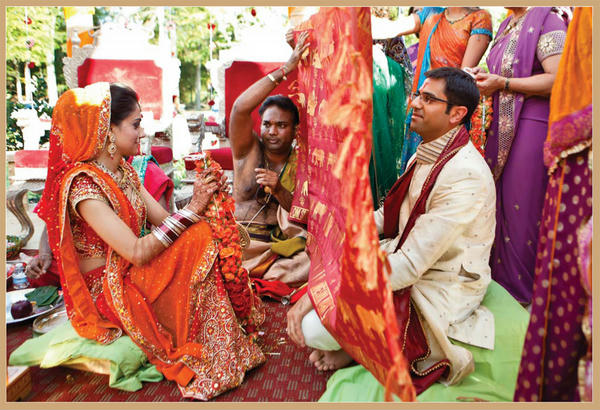
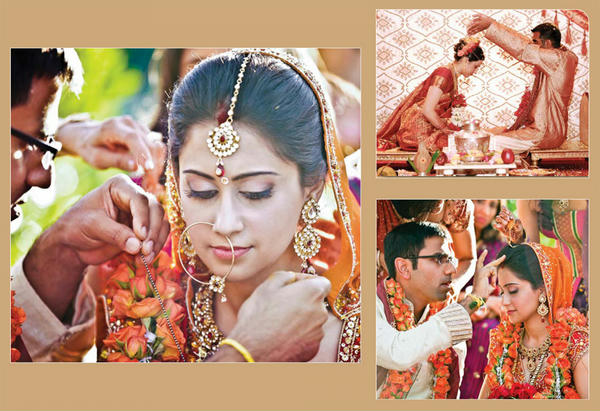
Commitments deepen: 1) A curtain held between groom and bride represents their separateness before marriage; 2) the groom adorns his bride with a mangala sutra; 3) they shower one another with unbroken rice; 4) he applies kumkum to the part in her hair.
• • • • • • • • • • • • • • • •§
Eight Auspicious Verses§
The bride and groom stand [or sit] facing each other, each holding a fresh flower garland. A cloth curtain is held between them so that they cannot see each other’s faces. The curtain symbolizes their separate identities prior to getting married. §
Eight auspicious verses (mangalashtakam) are sung by the purohita and/or family members to invoke blessings of God, rivers, etc. At the end of each verse, the purohita and invited guests collectively advise the couple “Shubha mangalam. Svadhana.” “Svadhana” means attention, and “shubha mangalam” means auspicious. The invited guests are advising the couple to pay keen attention to the commitments they are making to each other and to society on this auspicious occasion. Out of the eight verses traditionally recited, some may be specifically composed for the couple incorporating their names in the lyrics. Some are recited by relatives, such as aunts, uncles, siblings and cousins. Once the curtain is removed, the bride garlands the groom, then the groom garlands the bride. The removal of the curtain symbolizes that two lives are becoming one and there will be no secrets between them. This is one of the most important commitments the bride and groom make to each other. §
Expectations for Married Life§
As the bride and groom stand or sit facing each other, they express their wishes for life. One expresses a wish and the other responds by saying, “Let it be so; I will do all I can to make it so.” The bride and groom alternate. Each time, after the promise is made, one sprinkles akshata over the other’s head. The bride and groom are committing to work together in their married life to fulfill their duties in the following six areas: prosperity, religious duties, fame, duties towards the society, to children, and success in all endeavors. §
Tying the Sacred Necklace§
The bride’s mother presents the bride’s necklace, called mangala sutra, literally “auspicious thread.” It is sanctified by the purohita through a brief puja. The groom then places it on the bride, while reciting, “I place this mangala sutra around your neck as a symbol of our good fortune, love and friendship.” Nowadays most (not all) Hindus use a gold necklace with black and gold beads. Socially it serves as a symbol of a Hindu woman’s married status.§
Applying Kumkum to the Bride’s Forehead§
The groom then applies a red dot on the bride’s forehead and red kumkum powder in the part of her hair as a symbol of his commitment to protect her in all circumstances. These are well known symbols of her marriage status. While applying the kumkum, he recites this mantra: “May this tilaka of sindura forever nourish your status and esteem, just as the orb of the early morning sun enhances the beauty and glory of the Eastern skies.”§
Placing a Ring on the Groom’s Finger§
This is a Western custom adopted by Hindus in North America and elsewhere. It is not an essential part of the traditional ceremony. Bride: “I place this ring on your finger as a symbol of our love. Keep it safe and secure on your finger, and keep me safe and secure in your heart."§
Tying the Knot§
The purohita now instructs and guides the groom and the bride in performance of a Ganesha puja in which five betel nuts, dried roots of turmeric and some laddus are placed before the Deity. The purohita recites: “Lord Sri Ganesha, your physical stature is large. You shine with the brilliance of millions of Suns. Ignorant people do not know your real nature. Kindly remove all the obstacles in my undertakings.” After the puja, the groom’s stole and the end of the bride’s sari are tied together, with the sanctified betel nuts inside the knot. The knot is not to be undone until the ceremony is over. The image of the bride and groom circumambulating Agni (fire), thus tied together, is iconic for Hindu weddings, representing a bond for life. §
Acceptance of Hand in Marriage§
The groom accepts the bride’s hand in marriage while saying, “The Deities Bhaga, Aryama, Savitri and Indra have brought you to me so that we may together follow the difficult path of grihastha ashrama. I take your hand in my hand so we may receive good fortune. May we live together well into ripe old age” (Rig Veda 10.85.36).§
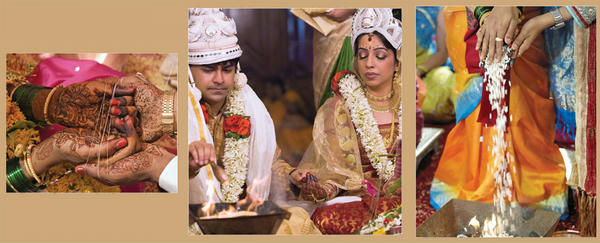
Joined by fire: 1) The joining of the hands bound with twine symbolizes the bonding of two souls, now one in body, mind, and spirit. 2) The groom and bride perform their first homa to seek Agni’s blessings. 3) The bride offers puffed grains into the fire, praying for a strong, harmonious relationship with her husband’s family. 4) Together they walk around the fire three times. 5) At the end of each round, the bride places her foot on a stone, symbolizing her strength to overcome all challenges. 6) During the seven-step ceremony, bride and groom together touch seven mounds of unbroken rice with their toe while reciting seven prayers.
• • • • • • • • • • • • • • • •§
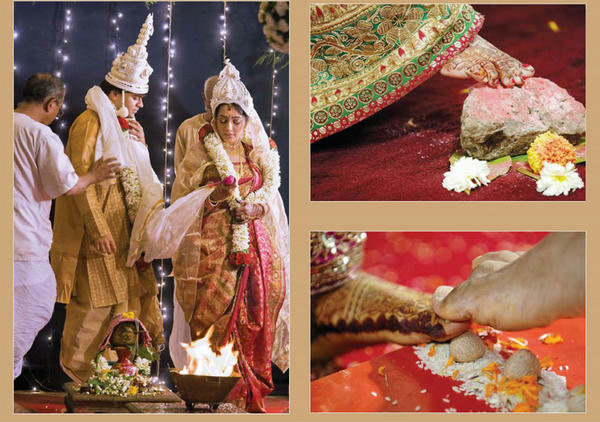
Seeking Agni’s Blessing through Homa§
In Vedic times it was customary to perform an Agni puja (sacred fire worship, also called homa) every day. The couple’s performing this ritual for the first time after getting married signifies their entry into grihastha ashrama (the householder stage of life). The groom recites, “Having accepted this bride as my wife, I will perform this vivaha homa in order to successfully and firmly establish her status as the wife and to establish the sacred fire in our household.” The bride sits on the left side of the groom and rests her right hand on the groom’s wrist as an indication of her participation in this vivaha homa. §
The groom recites a series of Vedic mantras. Each time “svaha” is uttered at a verse’s end, he pours a spoonful of ghee into the sacred fire, which burns in the homa-kunda (a small square pit holding the ritual fire, fueled by small pieces of dried wood). The couple is seeking Agni’s blessings for protection, purity, illumination of minds and a smooth relationship. §
Circumambulating the Fire & Ascending the Stone §
The groom places two fistfuls of popped grain and two spoonfuls of ghee in the bride’s hands. Then he places one hand beneath and one hand over the bride’s hands. The groom recites: “Aum! By making the offerings to Agni, this girl has worshiped God Aryama. May Aryama free this girl from attachment to her parents’ home and family, and not from an attachment to our home and our family. Svaha!” The bride and the groom then together offer the grain into to the fire. §
The bride and groom now walk clockwise around the sacred fire holding a pitcher of holy water and homa utensils. The groom holds the bride’s right hand and walks slightly ahead of her. At the end of the circumambulation she places her foot on a stone, and the groom expresses his wish that she become as strong as the stone she is standing on to form a strong household and face any adversity that may lie ahead in life. §
These actions (offering puffed grains, walking around the fire and standing on the rock) are repeated two more times. In the first round, the Vedic Deity Aryama is invoked in the form of Agni. In the second round, Varuna is invoked, and in the third, Pushana is worshiped. During each round, the groom recites this verse from the Grihya Sutras: “I am indeed the Prana. You are also the Prana. I am the Sky, and you are the Earth. I am a verse of Sama Veda, and you are a verse of Rig Veda. Let us be married. Let us have children. Let us endear ourselves to each other. With love and affection for each other, and with minds acting in unison, let us live a long and happy life of 100 years.” Finally, a fourth oblation is made to Prajapati, without circumambulating. §
The Rite of Seven Steps§
The purohita prepares seven small mounds of rice in a line for the bride and groom to step on. The bride and groom, standing next to each other, their stoles still tied in a knot, step on the mounds as instructed by the purohita. §
This is one of the most important parts of the ceremony. According to the 1956 Hindu Marriage Act of India, the circumambulations around Agni and the seven-step ceremony are recognized as the essence of a Hindu wedding. The sentiments expressed here provide the essence of the wife’s role in the marriage. In the traditional Brahma vivaha, the groom addresses the bride and expresses seven wishes for their married life. After each statement he repeats, “Become one with me in thought and action. May we be blessed with many children and may they enjoy a long life.”§
- Take this first step for the abundance of nourishment in life.
- Take this second step for strength in life.
- Take this third step for prosperity in life.
- Take this fourth step for the fulfillment of all earthly desires.
- Take this fifth step for procreation.
- Take this sixth step for the enjoyment of the various seasons of life.
- Take this seventh step for a lifelong friendship.
Groom: “Now that we have taken these seven steps together, we will be inseparable friends through the journey of life. May Ishvara give us life long enough to watch our many children and grandchildren grow and prosper.”§

The Auspicious Day: With foreheads touching, the couple receive blessings from the purohita. Bowing down and touching the feet of the parents in respect; receiving salutations from family and friends. In the Tamil and Telugu traditions, the groom places a ring on the bride’s toe just before she touches the stone after walking around the fire the first time.
• • • • • • • • • • • • • • • •§
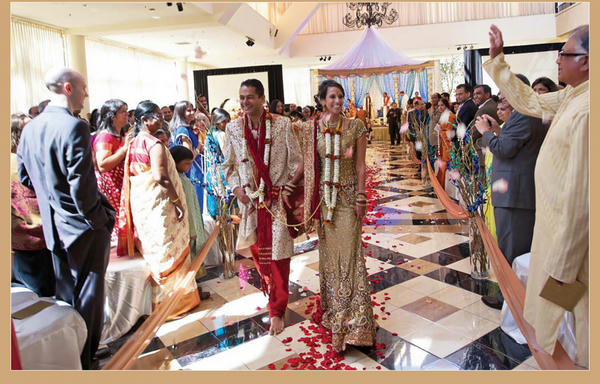
Rite of Seven Steps, Alternative Form with Joint Recitation§
In the traditional rite of seven steps, the bride does not have the opportunity to express her wishes. In order to emphasize the complementary nature of the husband-wife relationship, Vivaha Samskara provides verses to be jointly recited. These joint expressions, stated after an opening verse expressing a wish for everlasting love, make the rite of seven steps contemporary.§
Bride and groom together: “O Vaishvanara Agni, we are taking seven steps together to begin our united journey of life. May our love and affection for each other keep growing the way a river keeps swelling in the rainy season.” Then they together recite the following seven prayers. Prior to the first prayer, the groom says, “O Mistress of my heart! This is my first step with you.” And the bride says, “O Lord of my heart! This is my first step with you.” Together: “May we fulfill our duties with honor and become worthy of merit.” The groom and bride exchange similar complimentary verses before each step. §
- May we fulfill our duties with honor and become worthy of merit.
- May our home always be filled with wealth and sustenance.
- May we know all the joys that life has to offer.
- May our home be blessed with children and grandchildren.
- May our life together be peaceful & mutually nourishing.
- May our deeds bring pride to our families.
- May our two hearts beat as one.
After the final step, the groom and bride repeat together: “Since we have taken these ceremonial seven steps together, our minds have become one. May we shine like the moon and the moonlight.”§
Blessings by the Purohita§
Now the bride and groom stand facing each other, holding each other’s hands and their foreheads touching. The purohita sprinkles holy water on them and intones the following: “May you be blessed with prosperity, power, health, plenty of food, cattle, many children and a long life of 100 years. Let there be peace. Let there be nourishment. Let there be happiness.” §
Meditating on Dhruva, Arundhati & Saptarishi§
In this part of the ceremony, the groom and bride recite together with eyes closed: “We hold Dhruva [the pole star], Arundhati and Saptarishi [two constellations] dear to our heart. We bow down to them and pray to receive their blessings. They are the ideals of steadfastness and fidelity to all people on this Earth.” §
Final Salutations§
The newly married couple should now bow down to their parents, the purohita and all the elders in attendance and together ask for their blessings in these words: “Respected elders, parents and gurus, kindly accept the salutations from us, the newly married couple. You all attended this samskara out of your love and affection for us. We are eternally grateful to you for that. We pray to you to once again extend your best wishes to us.”§
The purohita recites a verse of blessing, and all the attendees follow him in unison: “May all be well with you. As long as the sacred river Jahnavi (Ganga) flows on this Earth, and as long as the Sun, protector of all beings, shines in the sky, may you live happily with your daughters, sons and grandchildren. And may your life be filled with beauty, grace and happiness. May all be well.”§
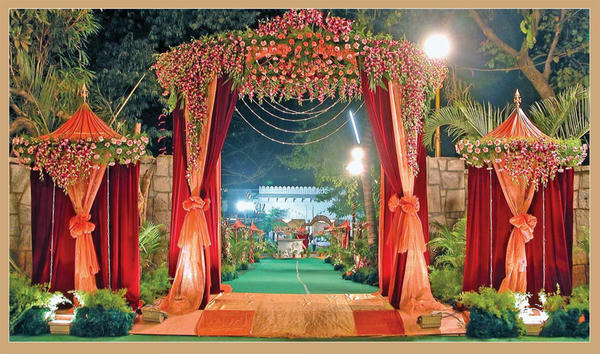
The Auspicious Day: An opulent outdoor wedding venue, lavishly adorned; an interfaith couple exchange garlands during their Hindu marriage ceremony
• • • • • • • • • • • • • • • •§
Weddings Logistics
FROM CHAPTER FIVE OF VIVAHA SAMSKARA§
 WEDDING IN A HINDU FAMILY IS ONE OF THE MOST JOYOUS events and is celebrated with gusto. Parents are generally deeply involved in organizing and paying for the event, because traditionally it has been the parents’ responsibility to conduct a proper wedding. It can be a multi-day, lavish event with guests normally ranging between 200 and 500. The events may include:§
WEDDING IN A HINDU FAMILY IS ONE OF THE MOST JOYOUS events and is celebrated with gusto. Parents are generally deeply involved in organizing and paying for the event, because traditionally it has been the parents’ responsibility to conduct a proper wedding. It can be a multi-day, lavish event with guests normally ranging between 200 and 500. The events may include:§
• Mehendi/Sangita/Garba: Also known as the “henna and music” party. Although Garba folk dances originated in Gujarat, they have become common among many non-Gujarati communities as well.§
• Pre-Wedding Puja: Worship to seek blessings prior to the main event. This can be a small, private, family affair. The brides from some communities perform a rite called Gauri-Hara puja just prior to the beginning of the main ceremony. A trained purohita can provide guidance in these matters.§
• Wedding Ceremony: The main ceremony.§
• Reception: Besides dinner and dancing, an entertainment program is generally presented by amateur artists who are friends and family.§
Elders: Apart from the bride and groom, the most common parties involved in the ceremony will be the parents of the couple. It is possible that one or both of the parents may not participate due to a variety of reasons, such as physical inability, death of one/both parents or unwillingness to participate. In such situations, the bride/groom should select someone she/he is emotionally close to, such as an uncle/aunt. The term elders is used generically in Vivaha Samskara. The purohita should customize the steps accordingly.§
Expenses: Some communities have the tradition of the bride’s parents bearing all the wedding related expenses. These days it is more customary for the two sides to contribute equitably. In an interfaith marriage, the issue of expense sharing may be more complicated. It is recommended that open discussions be held early on to resolve these issues.§
Muhurta: The auspicious day and time chosen for the wedding is called muhurta. It is traditionally chosen by consulting the purohita and in accordance with the Hindu panchanga (calendar). Many times there could be a clash between practical considerations, such as availability of a venue, and the dates considered auspicious.§
Venue Choice: Unlike Christian churches, Hindu temples will generally not conduct a wedding ceremony in the main temple itself. An adjacent hall may be used. Most popular choices for Hindu weddings are wedding halls or hotel ballroom facilities. Sometimes an outdoor wedding is desired. Weather plays a major role in the success or chaos of an outdoor wedding. An indoor ceremony is always easier to manage. A Hindu wedding does require the use of a ceremonial fire. As the hospitality industry in the diaspora gets more exposed to the use of a small ritual fire in Hindu weddings, it is becoming more common that the facility management will allow the use of fire. It is essential to check on this prior to engaging the facility.§
Essential Steps in the Hindu Wedding Rites
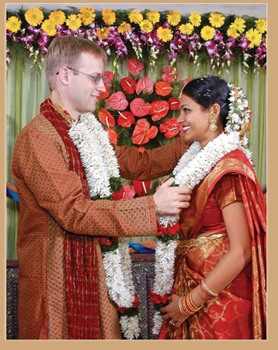 The Vivaha ceremony originates in the Rig Veda. Varying social customs have been added to the classic Vedic ceremony in different regions of India over the centuries. In spite of the regional differences, certain elements have remarkably remained common through several millennia, in spite of the difficulty of travel and communication in the olden days, in spite of the invasions by Muslim Turks, Mongols and Arabs and occupation by Christian Europeans. Seven steps from the Vedas form the core of today’s traditional rites:§
The Vivaha ceremony originates in the Rig Veda. Varying social customs have been added to the classic Vedic ceremony in different regions of India over the centuries. In spite of the regional differences, certain elements have remarkably remained common through several millennia, in spite of the difficulty of travel and communication in the olden days, in spite of the invasions by Muslim Turks, Mongols and Arabs and occupation by Christian Europeans. Seven steps from the Vedas form the core of today’s traditional rites:§
• Homaḥ: Oblation (offering) to Agni §
• Pāṇigrahaṇam: Acceptance of hand in marriage§
• Lājā-homaḥ: Offering of puffed grain into the fire§
• Agni-pradakshiṇā: Circumambulation of the homa§
• Aśmārohaṇam: Bride’s stepping on a stone§
• Sapta-padīḥ: Rite of seven steps§
• Dhruva-Arundhatī-Saptaṛshi Darśanam:
Reflecting on stars and constellations§
Two steps are traditionally added to the Vedic steps:§
• Śrī Gaṇeśa Pūjā: Worship of the Lord of Obstacles, performed at the start of the ceremony§
• Kanyā-dānam: The bride’s parents’ giving her to the groom§
The book Vivāha Saṁskāra provides two contemporary innovations:§
Ceremony Format: The wedding ceremony is what makes the event special. The rest of the celebration is a party! So, all steps that will be included should be decided early on, especially if it is going to be an interfaith wedding. Sometimes additional social customs are woven into the procedures. It is important that the purohita knows about these steps and how to incorporate them along with the Vedic steps.§
Stage and Mandapa: The canopy under which the ceremony is performed, called mandapa, should have four pillars, according to the shastras. The mandapa should be at least 12 feet square and set on a stage which is at least 18 inches off the ground. The minimum recommended size of the stage is 24 feet wide and 12 feet deep. Ideally the mandapa should face east. Invited guests should be seated in two sections with an aisle clear in the middle for the arrival and departure of the bride, groom and their families. The stage should be covered in white cloth to create a pure, clean and auspicious space. All participants stepping on to the stage are required to remove footwear.§
Audio-Video Recording: The photographers and videographers should not unduly interfere in the proceedings. Care should be taken to instruct them well, especially if they are not familiar with the Hindu wedding steps. The attending guests should have a clear view of proceedings. Sometimes this is achieved by having a live video display on a large screen.§
Music: During the ceremony, the presentation of appropriate music creates a serene atmosphere. The sound-system control person should coordinate the presentation of music with the purohita. Shehnai music is traditionally associated with Hindu weddings. There are many variations in the choice of music, depending on the region of India the families hail from. It is not uncommon to have live musicians perform.§
Dress Code: The bride and groom’s region of origin in India will greatly influence the style and color of attire. The purohita should wear simple attire worn by purohitas in India, such as a white dhoti and white/beige silk kurta. In the case of an interfaith wedding, non-Hindu participants may require assistance in selecting and wearing Indian attire.§
Review of Logistics: Besides the bride and groom, there are many individuals involved in a Hindu wedding ceremony, e.g., parents, siblings, uncles and aunties. Each must be informed and understand their role in the ceremony and be ready to perform it when required. This is not the same as a rehearsal in a Christian wedding. The purohita does not rehearse the ceremony prior to the actual wedding. §
Extra care should be taken in case of fusion weddings, as the non-Hindus involved may not be able to follow the purohita’s instructions well. Another important item to attend to is the collection of all required materials for the ceremony. The purohita, in the initial meeting, should supply a list of items required. Most wedding materials are now available in the West.§

